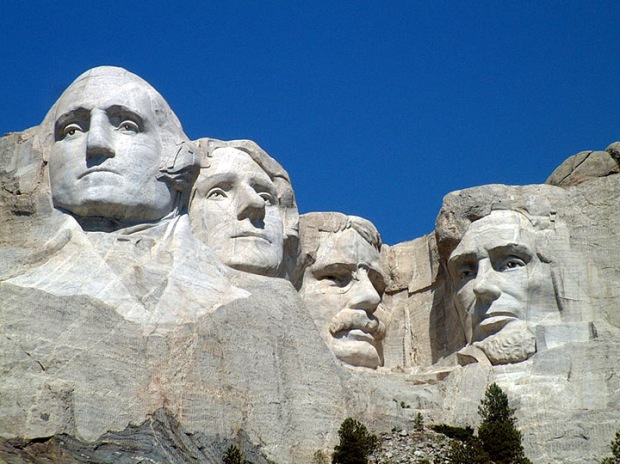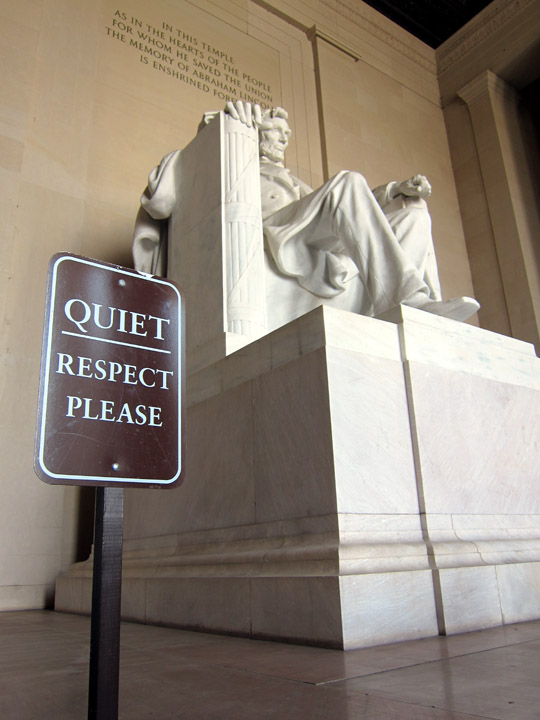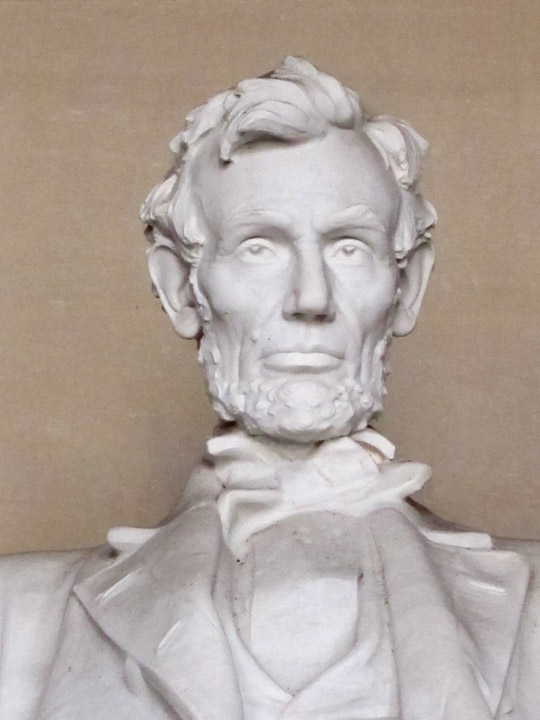Man and Myth: Interpreting Statues of Lincoln

Nothing says importance like being carved into a mountainside – Mount Rushmore National Memorial, near Keystone, South Dakota (Photo: Wikicommons)
The monthly ArtSmart Roundtable brings together some of the best art-focused travel blogs to post on a common theme. This month we are focusing on Sculpture. We’ve got picks from all over the world and different time periods. Be sure to check out all the posts below!
Statues always remind me of monuments and I am fascinated by how cultures remember their heroes. Living in Washington DC, I am surrounded by monuments to great American men. A lot of artistic thought goes into these sculptures because subtle, and not so subtle, visual choices shape how we view and remember these famous people. I think no other figure is wrapped in as much symbolic meaning and myth as Abraham Lincoln. Whether in books, art, or movies, we continue to struggle with who this president was and how we remember him. Two statues in DC epitomize this debate for me.
The Southern states were in the process of seceding from the Union when Abraham Lincoln (1809-1865) was elected President. A self-taught man known for his wit and intellect, Lincoln fought and won the Civil War and abolished slavery in the US. His presidency was difficult; some of this actions have been criticized as unconstitutional. Yet Lincoln is still regarded as one of the greatest Presidents by scholars and one of the most beloved by Americans today. – So how to we remember and honor such a man?
The Righteous and Divine Leader: The Lincoln Memorial
On one end of the National Mall in Washington DC sits the majestic Lincoln Memorial which resembles a neoclassical temple. In the heart of the shrine is a 19 foot tall marble statue of a seated Lincoln completed by Daniel Chester French. The figure sits in a deep, high-armed chair. He is slouching somewhat but maintains a respectable pose.
The sculpture is filled with symbolism. Lincoln’s left hand is closed demonstrating military determination, while his right hand is open and relaxed highlighting the need for forgiveness and reconciliation after the Civil War. The banded reeds on the front of the chair allude to a unified America. While based on photographic evident, the deeply worn face of the President is supposed to convey the struggles he endured even while he looks with resolve toward the horizon.

Like being in a tomb or church, signs within the Lincoln Memorial remind visitors to behave accordingly.
The Lincoln Memorial was constructed between 1914 and 1922 in a time when the mythology of Lincoln was at its peak. The nation had moved past reconstruction in the South and looked to raise up Lincoln as a great unifier and leader. Victory assured, we are reminded to have faith that justice and freedom will win in the end as long as there are great, steadfast men such as Lincoln leading our nation. The memorial captures this spirit and elevates Lincoln to an irreproachable height. We feel this distance looking at the massive seated statue and in the sacred atmosphere shrouding the memorial. Much like an ancient Greek temple, this statue feels like the cult figure of a God receiving visitors. The artist has definitely captured “greatness” in this presentation of the 16th President.
A Man Who Struggled for His Country: The Old Soldier’s Home
Many people don’t realize it, but during the summer months the Lincoln family relocated from the swampy White House to the Old Soldier’s Home a few miles away. Set up on a hill, this hospital for recently wounded veterans of the Civil War caught the cooling breezes and was a respite for the President. He “commuted” by horseback daily to his office in the White House, no doubt using the travel time to think about policy, strategy, and the many concerns of a war time President.
There is an excellent, life-sized statue of Abraham Lincoln (with his iconic stove-pipe hat) and his horse just outside the Lincoln Cottage on the Old Soldier’s Home grounds. This bronze piece was completed in 2008 by Brooklyn artist Ivan Schwartz. The statue has sharp knuckles and visible veins in this hands. We see the characteristic wrinkles of Lincoln’s cheeks but also the crows feet and deep bags under his eyes true to photographs from that time. We can approach the statue, look Lincoln in the eyes (or not quite, given his height), and stand in the man’s proverbial presence. Watching a tour group come and go, several people put there arm around Lincoln for a photo.
The museum staff at the Lincoln Cottage do an excellent job explaining why Lincoln very much needed an escape from the White House. Here we do not see a man that was emboldened by some divine providence. Visitors realize that Lincoln didn’t know if the nation would survive and was trying as hard as he could to hold the country together – all while feeling the weight of every life lost. This statue shows Lincoln tired and seeking some respite from his burdens.
It’s important to understand that many great accomplishment in American and human history have not been easy, but they were achieved by normal people called to do great things. While Lincoln was himself a humble man, I wonder if this very informal statue does not honor his sacrifices, talents, dedication enough.
So which statue do you prefer?
For the rest of the April ArtSmart Roundtable, see:
- Erin of A Sense of Place – The Overlooked Reliquary
- Lesley of CultureTripper – Francis Bacon & Henry Moore: Terror and Beauty, AGO, Toronto
- Murissa of Wander Traveler – The History & Highlights of Peggy Guggenheim’s Sculpture Garden, Venice
- Alexandra of ArtTrav – 8 exquisite sculptures at the Archaeological Museum in Florence
- Pal & Lydian of Art Weekenders – Botero’s Voluminous Sculptures Around the World
- Ashley of No Onions, Extra Pickles – Rodin’s Thinker
- Jenna of A Sense of Place – A Sense of Place through Sculpture









Fascinating post, Christina. The hands on the Lincoln Memorial are exquisite; I didn’t realize they were symbolic.
LikeLike
Thanks, the hands really are beautiful. Personally I like the President’s hair and how his clothing and blanket fold around him. There are several other urban legends about the statue that I didn’t get into.
LikeLike
As a Lincoln lover, I appreciated this post and never knew about the statue at the Old Soldiers Home. Also interesting that this post was published on the same day in history when Lincoln was shot; a warm commemoration for a sad day.
LikeLike
If you love Lincoln, you’ll definitely enjoy the Old Soldiers Home. His study is quite somber. Thanks for pointing out the 149th anniversary of this assassination! I didn’t even plan this to commemorate it – just a coincidence! 🙂
LikeLike
Interesting analysis of Lincoln as represented by the two statues. I was just in Lexington Kentucky and visited Mary Todd Lincoln’s home and was able to see some of the political and personal conflicts and challenges they faced during the Civil War.
LikeLike
That sounds great; I didn’t realize there was a house preserved in Lexington. I’ll have to check it out! I love historic homes! You definitely get a better sense for the daily life and concerns of the historic residents.
LikeLike
Very interesting piece. I haven’t really stopped to take a look (via internet anyways) at the Lincoln Memorial, which is my favourite of the two. I have yet to go to DC but would visit it if/when I do. The bronze, while much more approachable, invokes less awe in me and I am not a fan of bronze unless aged and in Italy.
Great post!
LikeLike
Thanks! The Lincoln Memorial is beautiful because it is modeled after a classical Greek temple so you definitely get that awe factor. Hope you can make it to DC someday!
LikeLike
What a great topic! I’m always interested in the ways that world leaders are portrayed through art, though never think to write about it. I visited the Lincoln Memorial years and years ago when I was in high school. I recall being impressed, but also a bit overwhelmed in general (did a whirlwind tour of DC in just a couple days). What I find the most interesting is the contrast between these two sculptures – the Lincoln Memorial, in the capital and very much on display, Lincoln is larger than life. He’s a stern and strong, but compassionate, leader. The bronze sculpture, however, depicts a man away from the spotlight. The realistic approach of the sculptor shows a man struggling with the weight of a country. These would make a brilliant art history compare and contrast essay question 😉
LikeLike
Thanks! Analyzing how art is used to comment on historical figures and events is really interesting to me too! Where’s the line in come cases between justified honor and revisionist propaganda? And then what is just over the top period styling?
It poignant to see these two statues in DC, although I think few people go to see the bronze one. There are also several Lincoln statues in Illinois depicting aspects of his childhood and rise to power that also enrich the sculptural Lincoln understanding.
LikeLike
Interesting choice! I’ve never made it to either of these in my trips to DC (too busy with museums!), but I really enjoyed the contrast between the two. The Memorial is very traditional and really evokes a Parthenon quality to a giant seated “God”, whereas the more modern take on a “human” Lincoln probably would have never been accepted at the time when the Lincoln Memorial was built. I think I prefer the Lincoln Memorial because it respects its neoclassical surroundings, but I’m really not a bronze fan either. I’m sure the curators have to keep an eagle eye on it since it’s now a frequent occurrence for people to try to steal outdoor bronzes for the scrap.
LikeLike
As someone who always tries to imagine the original interior and cult statue in the ruins of ancient temples, I love the classical qualities of the Memorial. I just worry about editorializing historical figures too much with our artistic choices. Like you mention, the Lincoln sentiment was very different at the time the memorial was built versus today.
I totally do not blame you for being in DC’s museums! The big ones are free and make for such a cool summer afternoon when it’s in the 90’s outside.
LikeLike
Interesting to learn more about the life of Lincoln via these statues. The Memorial also has my preference, not only because of the material used, but also since it really depicts him as a leader. For the opposite reason I can also imagine other people preferring the bronze statue, as it shows he’s more a man of the people.
LikeLike
It’s interesting how the same man can be considered in such different lights! I think both statues are appealing so you can’t go wrong with which ever one appeals to you.
LikeLike
An interesting post, Christina, especially since I hail from Illinois, the so-called ‘Land of Lincoln.’ 🙂 Fascinating to learn about the symbolism behind the Lincoln Memorial, in particular.
LikeLike
Thanks! For me, it’s hard no to think about the inherent symbolism and artistic choices when looking at Presidents or other important figures in art. Celebratory or memorial art is most often about the figure’s legend which is why I find the Soldier’s Home “Lincoln” so interesting.
LikeLike